We test the Trek Domane 2023 SLR 6, the perfect type of bike for a large majority of riders
In the sector of long-distance road bikes there are certain models that are setting trends and the Trek Domane is one of them. Since its appearance in 2012 it has been evolving until this fourth generation where comfort is closer than ever to speed. We tested the SLR 6 version, with the top of the range frame and a more affordable setup.
Trek Domane SLR 6: comfort and efficiency go hand in hand
The fourth generation of the Trek Domane brings this long-distance model to a level of performance and efficiency very close to Aero or ultralight models, while retaining maximum comfort and versatility.
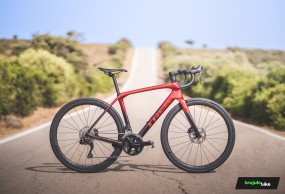
On many occasions we see that the endurance or gran fondo models are relegated by the brands themselves to a secondary role and sometimes it is the case that there are no models with the best equipment. This is not the case of Trek, where they provide their Domane model with the highest technology, reaching the level of being used, with great success, by professionals in some classics where the sterrato or pavé is present.
RECOMENDADO

The best apps for cycling and mountain biking

Black Friday 2025 cycling bargains: save on Garmin, POC, Maxxis and more

Black Friday Garmin 2025: the ultimate guide to choosing your GPS at the best price
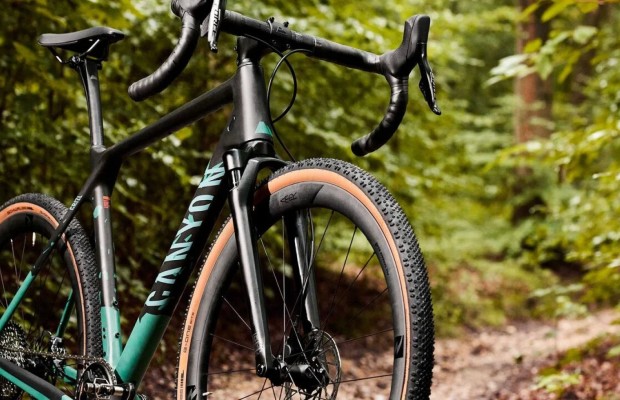
Do you need suspension on your gravel bike?
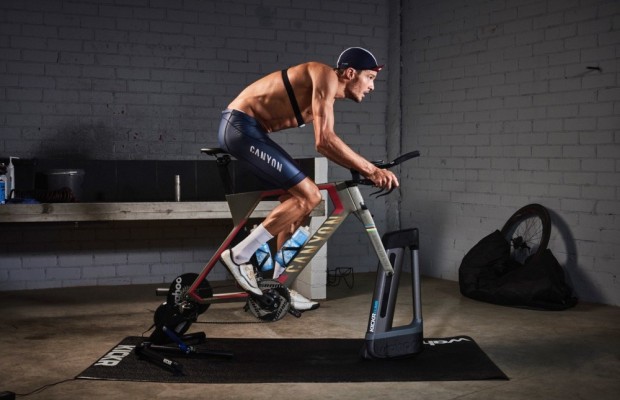
A real workout saver of only 56 min on the turbo trainer

Which profile wheels to choose according to the area where you live: mountain, flat or coast
Starting with the frame of our test unit, the SLR version is built with Trek's best carbon fiber, the OCLV 800 series. In this fourth generation they have managed to significantly reduce the weight compared to its predecessor.
The most striking feature of the Domane frame is the so-called IsoSpeed which, in this fourth generation, is found only at the rear. It has also been redesigned and simplified, making it lighter and more integrated than ever.
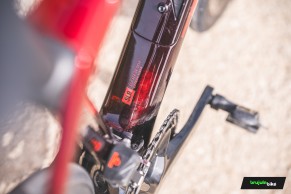
IsoSpeed is a seatpost clamp system that is decoupled from the frame's down tube, allowing the seatpost to flex to absorb vibrations and small impacts.
To adjust the saddle height, simply remove a cover to access the adjustment screw. With this cover, the integration is very successful and combines functionality and aesthetics.
The shape of the frame is very striking. In general, the tubes are somewhat oversized and there are quite a few profiled areas with the intention of favoring the aerodynamics of the Domane.
The head tube area is particularly striking, with flattened side faces and a truncated profile finish, which is also present on the down tube and even on the seat post. In this area we find the IsoSpeed, whose integration also favors aerodynamics. Here the seat stays are anchored in their upper part, highlighting the separation between them to favor the wheel arch of up to 38mm offered by the frame.
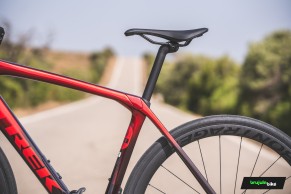
The oversized bottom bracket area contributes to the use of a threaded bottom bracket with T47 internal bearings. A great solution that maximizes the stiffness and integration of the bottom bracket area and simplifies maintenance.
The Trek Domane does not forget that it is a long-distance bike and in different corners of its frame and fork we see arranged a series of threads to anchor luggage racks or accessories, as well as extra bottle cages. Some anchorages arranged in the most discreet way possible, in an exercise of integration as we have rarely seen.
But the Trek Domane frame hides yet another secret. It is a hatch under the bottle cage to access the inside of the down tube where we can store various tools in a bag for this purpose and a multi-tool under the lid itself.
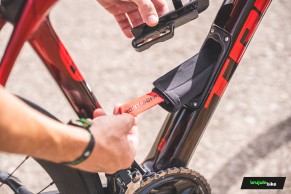
Apart from being useful, it is a very well achieved mechanism that goes quite unnoticed once closed.
In a frame with this level of detail and finish, the internal wiring could not be missing, with the hoses entering under the stem through the steering.
In terms of geometry, we find measurements that make the Trek Domane a docile and stable bike, as the long-distance bike that it is, but trying not to lose that agility necessary in a bike that, as we have already said and has been proven at the professional level, does not turn its back on competition.
Thus, the measurements that give it that big-bottom character are its slightly relaxed steering angle of 71.3° in size 54, a 160mm head tube in the same size and 420mm chainstays resulting in a generous length of 1010mm between axles.
The rest of the measurements follow the trends in performance bikes, such as its 374mm reach or its 73.7° down tube angle.
High-end setup and the new 105 Di2
The Trek Domane SLR 6 is framed in the third step of the range and is the first model to mount the exclusive SLR frame. It is not a cheap bike, as it comes to market at a price of 7,999 €. Therefore, apart from the technology applied to its frame, it is equipped with high quality components.
Starting with the wheels, Bontrager Aeolus Pro 37 TLR, with OCLV carbon rim and a balanced 37mm profile. The hubs, although customized for Bontrager, are DT Swiss 350 and are mounted with DT Aerolite spokes, a guarantee of the highest quality.
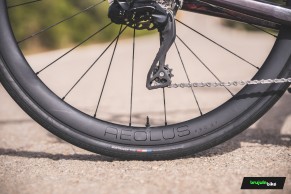
On the Aeolus wheels are mounted Bontrager R3 Hard-Case Lite TLR tyres in 32mm width. Tubeless tyres with enough width to have no problems on the worst roads or even dirt tracks with a good surface.
Another top quality component that fits perfectly on this bike is the Bontrager Pro IsoCore VR-SF handlebar, made of carbon with the IsoCore laminate that is designed to absorb vibrations in combination with the IsoZone EVA pads under the tape. In addition, its studied shape is designed to easily reach the levers in any position.
In conjunction with the handlebars we have the Trek RCS Pro stem that guides the hoses to the spacers and the steering in a very discreet way.
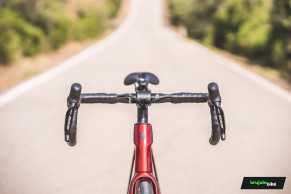
The Domane carbon seatpost, as mentioned above, has an aerodynamic truncated profile shape, or as they call it, KVF shape (Kammtail Virtual Foil).
The Bontrager Verse Short Elite saddle is mounted on it, with hollow rails and a look and shape that we liked very much and whose comfort we have been able to verify in our tests.
And to complete the setup of the Trek Domane SLR 6 we have the complete Shimano 105 Di2 groupset, a recently introduced groupset in which Shimano extends electronic operation to the mid-range.
This is a groupset with wireless levers and 12 sprockets on the cassette, just like the superior versions. These 12 sprockets allow the mounting of an 11-34 cassette without a very abrupt staggering and gives us a very wide range together with the 34-50 crankset.
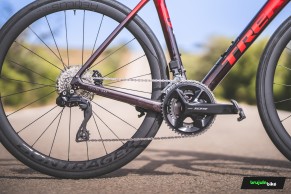
Braking performance is also guaranteed with Shimano 105 brakes with 160mm discs on both wheels.
Riding with the Trek Domane SLR 6
The first impression when we received the bike was that we were looking at something different. Normally, long-distance bikes are not aesthetically the most striking. We tend to look more towards ultralight bikes or, above all, aero bikes, but with the Domane it's a different story.
From the first moment, its shapes are striking, highlighting the oversized top tube, the profiling of the steering area and also the upper crosshead, which houses the IsoSpeed, is very well integrated and aesthetically finished.
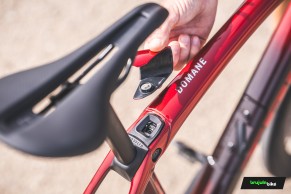
Also, as we have advanced, all the accessory attachment points are very well integrated and, at first glance, the aesthetics are very clean.
The truth is that the Domane caught our eye as soon as we saw it. Now it was time, as usual, to put it through our scales and put it to the test.
We weighed it and it came in at 8.32 kg. It's not going to break any lightness records, but that's not its purpose either, and considering the Domane's characteristics we think it's a good weight.
It was time to adjust our position and here we found that our unit came with the head tube uncut and the spacers, added to the 160mm of his pipe, we placed the handlebars too high for our taste. Nothing that can't be solved by reversing the position of the spacers. Even so, we placed the handlebars a little higher than on our usual bike because, being a long-distance bike, we wanted to test it in its essence.
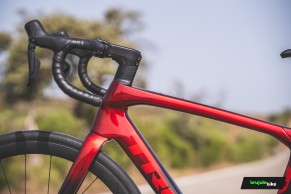
After the rest of the adjustments, we put the pedals on and went out for a ride.
The first few meters we were mostly concerned with the position and, as expected, it is quite comfortable, but with the adjustments made to the stem it is not much different from what we can carry on a pure performance bike.
The first kilometers we rode on good roads and predominantly flat terrain. Here we were pleasantly surprised by the Domane's good handling. It is very easy to maintain a high speed.
This detail a priori may be surprising for many, considering that it has 32mm tubeless tyres with a maximum pressure of 5 bar. And the truth is that when this trend of such wide tyres started we were also shocked, but after so many tests in the field we are already well aware that a slightly wider tyre and at pressures much lower than what has been common for many years, does not limit at all the easy and fast riding. The only negative aspect is the increase in weight, but the gain in comfort and grip is spectacular.
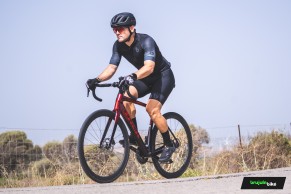
When the road started to get rougher and rougher is when we really saw the great virtues of the Trek Domane SLR 6. We can't put it down to a single detail, because all the technologies present on the Domane work together, but the smoothness with which we passed through all the stretches of road in bad conditions is amazing. The wheels and those 32mm tyres play an important role, but we don't notice the shocks that the saddle of a road bike usually transmits, and this seems to be due to the IsoSpeed system. Likewise, our wrists were spared the vibrations and impacts typical in rough areas during our time on the Domane.
A detail that, in these conditions of not very smooth roads caught our attention, is how quiet the Trek Domane is. Where with most bikes there is always some noise derived from the vibrations of the road itself, with the Domane everything is smooth and quiet.
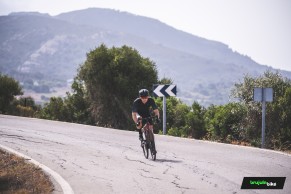
We also put the Trek Domane to the test in more mountainous terrain. On the climbs we have the advantage of the comfort of the ride and the gearing of the 105 Di2, with its 11-34 that gives us the certainty that we will not get stuck on any ramp or suffer more than we intended. But we discovered another of the great virtues of the Domane frame, and that is its tremendous lateral stiffness. The bike behaves like a real block and pedaling, both sitting and especially standing, transmits every watt we bring to the rear wheel. It is clear that a comfortable frame does not have to stop being laterally stiff or have unwanted flex losses and the Trek Domane confirms it.
But on climbs we also noticed that the Domane SLR 6 is not as responsive as an ultralight bike. Overall it's a heavier bike than a pure climbing bike, and part of that extra weight is in the wheels, specifically the tyres. So it's not a bike where we're going to enjoy lightning-fast changes of pace, nor will we notice that lightness when we swing the bike upright.
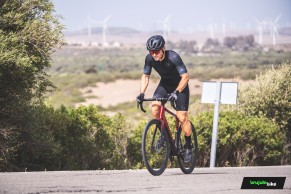
We have said that the Domane brings out its virtues when the terrain gets complicated, but another of the scenarios where it excels is in the descents. The confidence that the Trek Domane transmits when the terrain slopes down is amazing.
Geometrically, the Domane is tremendously stable, but if we add to that a stiff frame, 32mm Bontrager R3 tyres, and all the technologies focused on vibration absorption, the Domane is one of the bikes that has offered us the greatest safety in all types of descents.
As for the performance of the Shimano 105 Di2 groupset, we can only praise the smoothness and precision of the shifting. This is not the first time we have had the opportunity to test this electronic 105 version and, once again, it has offered us a performance similar to that of the superior versions. Only a slight increase in weight separates it from the performance of the best groupsets manufactured by Shimano.
Trek Domane SLR: the perfect type of bike for a large majority of riders
Our conclusions after riding the Trek Domane SLR 6 for a while are really positive.
In general, we amateur cyclists want to ride bikes identical to those ridden in the professional peloton, but in most cases we don't get the same advantage from an extreme aerodynamic position, nor is our body, either because of age or hours spent training, as prepared for the discomfort that comes with a bike with the adjustments of a Pro Tour rider.
The Trek Domane is a bike that, while still being very efficient and fast, as demonstrated in its palmares, has all the goodness so that spending many hours pedaling on it does not become a torture, and that in the most demanding routes are the legs, rather than the back or wrists, which say how far we are able to go.
The Trek Domane range, in its fourth generation, is offered in a wide range of options. Up to 6 models are available with SLR frame like the one we tested and 5 models with the Domane SL frame. The prices, speaking of carbon frames, range from 3,181€ for the Domane SL 5 model, up to 14,499€ for the exclusive Domane SLR 9 AXS model. Below that we find four more options with aluminum frame.
The Domane SL frame can be purchased separately for €3,199 and the Domane SLR for €5,299.
Trek Domane SLR 6: specifications, weight and price
- Frame: OCLV 800 Series Carbon, IsoSpeed, internal storage
- Fork: Domane SLR Carbon
- Controls: Shimano 105 R7170 Di2, 12-speed
- Rear Derailleur: Shimano 105 R7150 Di2
- Shifter: Shimano 105 R7150 Di2
- Crankset: Shimano 105 R7100, 50-34
- Bottom bracket: Praxis T47, threaded, internal bearing
- Cassette: Shimano 105 7100, 11-34, 12-speed
- Chain: Shimano SLX M7100, 12-speed
- Brakes: Shimano 105, BR-R7170, flat mount, 160mm discs
- Wheels: Bontrager Aeolus Pro 37, OCLV carbon, 37mm profile
- Tyres: Bontrager R3 Hard-Case Lite, Tubeless ready, 120tpi, 700x32mm
- Stem: Trek RCS Pro, -7º
- Handlebar: Bontrager Pro IsoCore VR-SF
- Seatpost: Domane Carbon, KVF, 20mm backtracking
- Saddle: Bontrager Verse Short Elite, hollow steel rails.
- Weight: 8,32kg
- Price: 7,999€